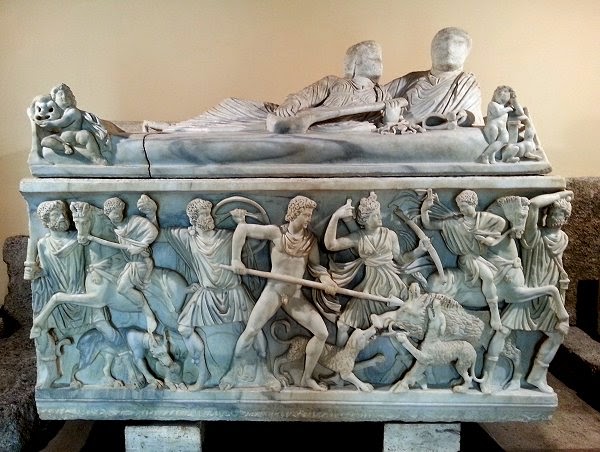Palazzo del Senatorio ( built in the 12th Century and now the Roman city hall )
overlooking the Piazza with the 2 museums on either side facing towards each other
overlooking the Piazza with the 2 museums on either side facing towards each other
and joined by a subterranean passageway ...
The historic museums are housed in two palaces facing each other - the Palazzo dei Conservatori ( 16th C ) and Palazzo Nuovo ( 17th C ) )... and facing in onto the central piazza in a plan conceived by Michelangelo in 1536 and executed over a period of more than 400 years.
Palazzo dei Conservatori
Entrance to Palazzo dei Conservatori
with a sneek view of another copy of David ...
Not as impressive as the original ...
The history of the museums can be traced to 1471, when Pope Sixtus IV donated a collection of important ancient bronzes to the people of Rome and located them on Capitoline Hill. Since then, the museums' collections have grown to include a large number of ancient Roman statues, inscriptions, and other artifacts; a collection of Medeival and Renaissance art; and collections of jewels, coins and other small objects d’art. Open to the public in 1734 under Clement XII, these are considered the first museums in the world - understood as a place where art could be enjoyed by all and not only by the owners.
The blogger making a point ...
Up a few flights of stairs to the first gallery for an exhibition of selected sculptural works by Michelangelo marking the 450th anniversary of his death ... ( unfortunately no photography allowed in the exhibition - sorry ... )
A glimpse into the exhibition ... and that's all ...
Then it was on to explore the rest of the Palazzo - the artworks are exhibited in several beautiful galleries throughout the palace ... the first to visit is on the second floor - here the rooms are decorated with carved ceilings, elaborate frescoes, marble tiled floors and hung with tapestries ... and very impressive chandeliers ...
Boy with Thorn, also called Spinario -
Greco-Roman Hellenistic bronze sculpture
The Capitoline Wolf is a bronze sculpture of a she-wolf suckling twin
infants, inspired by the legend of the founding of Rome. According to
the legend, when Numitor, grandfather of the twins Romulus and Remus,
was overthrown by his brother Amulius, the usurper ordered the twins to
be cast into the Tiber River. They were rescued by a she-wolf who cared
for them until a herdsman, Faustulus, found and raised them. Once they reach manhood - they discover their real identity - kill Amulius - restore Numitor to the throne - and eventual set out to found a new city
Romulus wants to found the new city on the Palatine Hill; Remus prefers the Aventine Hill. They agree to determine the site through omens but when each claims the results in his own favor, they quarrel and Remus is killed. Romulus founds the new city, names it Rome, after himself, and creates its first legion and senate.
The new city grows rapidly, swelled by landless refugees; as most of these are male, and unmarried, Romulus arranges the abduction of women from the neighboring Sabines. The ensuing war ends with the joining of Sabines and Romans as one Roman people. Thanks to divine favour and Romulus' inspired leadership, Rome becomes a dominant force, but Romulus himself becomes increasingly autocratic, and disappears or dies in mysterious circumstances.
The new city grows rapidly, swelled by landless refugees; as most of these are male, and unmarried, Romulus arranges the abduction of women from the neighboring Sabines. The ensuing war ends with the joining of Sabines and Romans as one Roman people. Thanks to divine favour and Romulus' inspired leadership, Rome becomes a dominant force, but Romulus himself becomes increasingly autocratic, and disappears or dies in mysterious circumstances.
The age and origin of the Capitoline Wolf is a subject of controversy.
The statue was long thought to be an Etruscan work of the 5th century
BC, with the twins added in the late 15th century AD, however,
radiocarbon dating has found that the wolf portion of the statue was
likely cast between 1021 and 1153.
Torso of a Sea Centaur - 191 AD
Bust of Emporer Commodus as Hercules - 191AD
What a delight ...
I had the entire museum almost to myself ...
I had the entire museum almost to myself ...
After all that marble - it was up to the third floor where the museum houses its painting and applied arts collections ... however I didn't record very much of this section as there was a whole other museum full of more marble to be explored and I was anxious about running out of power in my camera ... !!!
Saint John the Baptist - Caravaggio - 1601
The Fortune Teller - Caravaggio - 1595
Gallery devoted to a beautiful collection of porcelain ...
Then it was down into the basement and across under the Piazza
to the Palazzo Nuovo for another dose of ancient Roman marble ...
More to come ...



















































No comments:
Post a Comment
Note: Only a member of this blog may post a comment.